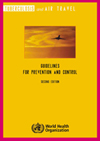
WHO is working closely with the United States Centers for Disease Control and Prevention (CDC) and other national authorities following the issue of health advisories in connection with an air passenger from the USA who travelled to Europe while affected by XDR-TB. CDC is carrying out investigations in line with those recommended in the WHO Tuberculosis and Air Travel Guidelines. The guidelines include measures that should be considered by relevant authorities to limit the risks of transmission of infectious TB.
Why has a health advisory been issued?
Health authorities are seeking to identify and locate the passengers who sat within two rows of the individual and then recommend what those people should do to determine whether or not they have been infected with TB. This approach is consistent with the WHO TB and Air Travel Guidelines for TB contact tracing.
Is there a risk of TB infection during air travel?
WHO's TB and Air Travel Guidelines emphasize that under normal conditions the quality of the air on board commercial airliners is higher than it is in most buildings. Passengers travelling on flights longer than eight hours may be at higher risk of becoming infected with TB if they sit near someone with active TB, but the risk should be similar to what it is in other circumstances where people are together in a confined indoor space. Brief contact with an infectious individual poses little to no risk of becoming infected with TB.
What are the specific factors that should be taken into account?
- Infectiousness of the patient with TB - Public health authorities only need to do contact tracing if the person with TB was infectious at the time of the flight - meaning, the person was capable of spreading infection.
- Duration of exposure - The total length of the flight, including time on the ground after boarding, flying time and time on the ground after landing, must be taken into account. Evidence of transmission of TB has been found only when exposure to the person with TB exceeded eight hours.
- Proximity of an infectious passenger to other passengers and crew - Passenger-to-passenger transmission has been documented only among people seated in the same section as the person with infectious TB.
What advice should be given to patients who fear they may have been infected?
- People who fear they may have been infected with TB should see a physician or go to their local health department and request a TB test, which should include an evaluation of signs and symptoms of TB, a TB skin test or the Interferon-Gamma Release Assay (IGRA) to test for TB infection, and possibly a chest x-ray.
- If needed, they should return to the healthcare provider for a second TB test 8–10 weeks later.
- They should keep a copy of their test results; and if they ever experience any signs or symptoms of TB disease (cough, weight-loss, fever, and night sweats), see a physician promptly, regardless of previous test results
- Even persons who have received the BCG vaccination to prevent development of TB disease should be tested for TB if they believe they have been exposed to the disease.
What is XDR-TB?
XDR-TB is a relatively rare type of drug-resistant TB that is resistant to almost all drugs used to treat TB. Cases of XDR-TB has been confirmed in 37 countries to date.
- WHO tuberculosis and air travel guidelines
- Information on XDR-TB
- USA Centers for Disease Control and Prevention
